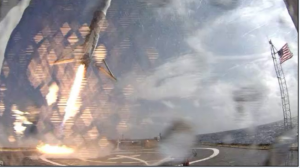By Wes O’Donnell
Managing Editor of In Military, InCyberDefense and In Space News.
This week in 2015, SpaceX CRS-6 (Commercial Resupply Service) launched SLC-40 from Cape Canaveral, Florida, to fly supplies to the International Space Station. CRS-6 was the eighth flight of SpaceX’s unmanned Dragon cargo spacecraft. It was also the sixth NASA-contracted SpaceX operational mission under a Commercial Resupply Services contract. It was docked to the International Space Station from April 17 to May 21, 2015.
Get started on your Space Studies Degree at American Military University. |
Dragon’s Primary Payload
The Dragon spacecraft was filled with 2015 kg (4,387 lbs) of supplies and science payloads, including critical materials to directly support about 40 of the more than 250 science and research investigations that will occur during Expeditions 43 and 44.
A company called Planetary Resources deployed the “smallsat” from the ISS via a NanoRacks-provided service, in an attempt to validate and advance the technology of its Arkyd series of spacecraft.
Planet Labs, another private company, transported 14 Flock-1e Earth observation cubesat satellites for deployment from the space station via an agreement with NanoRacks, operator of the Center for the Advancement of Science in Space (CASIS).
In addition, CRS-6 included science payloads for studying new ways to possibly counteract the microgravity-induced cell damage seen during spaceflight, the effects of microgravity on the most common cells in bones, and gather new insight that could lead to treatments for osteoporosis and muscle-wasting conditions.
The science payload also included continued studies into astronaut vision changes and a test for a new material that could one day be used as a synthetic muscle for robotics explorers of the future.
Landing a Reusable Rocket

After separation of the second stage, SpaceX conducted a flight test and attempted to return the nearly empty first stage of the Falcon 9 through the atmosphere and land it on a 90-by-50-meter (300 × 160 feet) floating platform called the autonomous spaceport drone ship.
The unmanned rocket technically landed on the floating platform. However, it came down with too much lateral velocity, tipped over, and was destroyed.

Comments are closed.